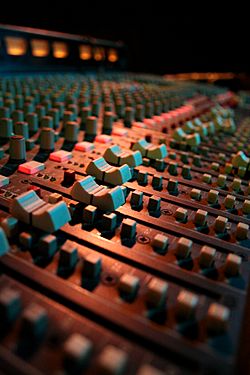Fade (audio engineering) facts for kids
In the world of audio engineering, a fade means making the sound level go up or down slowly. When the sound slowly gets louder, it's called a fade-in. When it slowly gets quieter, it's called a fade-out. This idea is also used in movies for lighting and scenes.
Imagine a recorded song. It might start quietly and slowly get louder (a fade-in). Or, it might end by slowly getting quieter until it's silent (a fade-out). For example, "Bitter Sweet Symphony" by The Verve starts with a fade-in. Songs like "Born to Be Wild" by Steppenwolf and "Hey Jude" by The Beatles end with a fade-out. Some fade-outs are quick, like in "Born to Be Wild." Others, like "Hey Jude," can take a long time – over two minutes! Fading out can be a good way to end a song that doesn't have a clear stopping point.
Sometimes, a song might fade out and then fade back in again. This is pretty rare! A few examples are "Helter Skelter" by The Beatles and "Suspicious Minds" by Elvis Presley.
The word 'fade' is also used in cars or other places with many speakers. It helps balance the sound between the front and back speakers.
How Fades Started
One of the earliest uses of a fade-out in music was in "Neptune," a part of the orchestral suite The Planets by Gustav Holst. He wanted the women's choir to sound like they were far away. He wrote that they should be in another room, and the door should slowly close. This made the sound slowly disappear, as if it was "lost in the distance." This effect was amazing for audiences back in 1918, before recorded music was common.
The idea of fading out sound goes way back to the first days of recording. In old recordings, before electricity was used, people would make the sound fade by moving the singers or instruments away from the recording horn. Or, the performers would just sing or play more and more quietly. When electrical recording came along, it became much easier. Engineers could just turn a knob on a mixing desk to slowly lower the sound.
It's hard to say which recording was the very first to use a fade. Some people think an 1894 record called "The Spirit of ’76" might be one of the earliest. It had music that got louder as it "came closer" and quieter as it "moved away." Many believe that movies also influenced fades. Fade-ins and fade-outs are common in films to start and end scenes. The term 'fade-out' itself first appeared in print around 1918, around the same time these recording techniques were developing.
What is a Fader?
A fader is a special control used to make sound levels go up or down. It's usually a knob or button that slides along a track. If it's a knob that turns, it's usually called a "potentiometer" instead of a fader, even though it does the same job.
Faders can be:
- Analog: These directly control the electrical signal, like a Potentiometer.
- Digital: These control a digital signal processor (DSP) using numbers. Digital faders are sometimes called virtual faders because you can see them on a computer screen in a digital audio workstation.
Some fancy digital mixers have faders that can move by themselves! They jump to the right position for different settings or functions.
What is Crossfading?
A crossfader is a special control often found on a dj mixer. Think of it like two faders connected together, but working in opposite ways. It lets a DJ slowly turn one sound source down while at the same time slowly turning another sound source up. This is super helpful when a DJ wants to smoothly switch between two phonograph records or CDs.
Crossfading is also a useful trick in audio engineering. For example, if a musician records a solo several times, an engineer can take the best parts from each recording. They then use crossfading to smoothly blend these best parts together into one perfect solo.
Different DJ mixers might have crossfaders that work in slightly different ways. Some high-end mixers even let the DJ choose how the crossfade will happen, depending on if they are scratching, beatmixing, or just cutting between songs. Experienced DJs can also use the regular channel faders to crossfade between tracks.
Many computer programs also have virtual crossfaders, like software used for burning audio-CDs.
- Middleton, Richard (1990/2002). Studying Popular Music, p. 95-6. Philadelphia: Open University Press. ISBN: 0-335-15275-9.
Images for kids
See also
 In Spanish: Fundido (audio) para niños
In Spanish: Fundido (audio) para niños



